| |
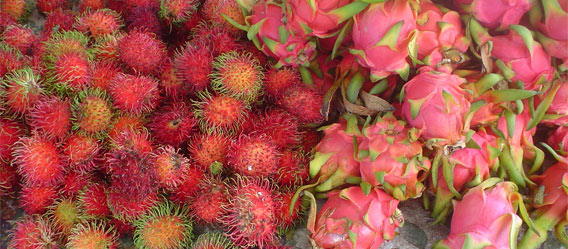
When talking about Asian fruits, we are entering into a whole exotic world of flavors, smells and tastes and unique looks that can be an eye opener into the amazing variety that the Mother Nature offers.
Because of the varied climates of the Asian continent, the fruits that come from Asia are just as varied. A wide variety of unique tropical fruits come from Southeast Asia and South Asia. East Asia also boasts of its own unique species. This month, we will journey into the world of Asian fruits and experience some of the interesting and unique sights, smells and tastes.
King and Queen of Fruits
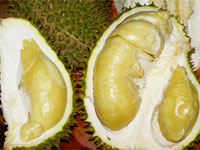 In Asia, the title of the "King of Fruits" goes to a unique fruit that at first sight and smell may be a put-off to many. A large fruit with a greenish brown hard spiky shell that has been described by many foreigners to smell like "gas leakage" or "dog droppings"-the durian is the undisputable King of fruits with its impressive appearance, and its unmistakable smell. But once you get past its hard spiky exterior, its insides are a rich silky golden yellow. What many has termed as a distasteful smell of the fruit, for the lovers of this fruit is one of its distinctive mark of the full rich experience that durians offer. In Asia, the title of the "King of Fruits" goes to a unique fruit that at first sight and smell may be a put-off to many. A large fruit with a greenish brown hard spiky shell that has been described by many foreigners to smell like "gas leakage" or "dog droppings"-the durian is the undisputable King of fruits with its impressive appearance, and its unmistakable smell. But once you get past its hard spiky exterior, its insides are a rich silky golden yellow. What many has termed as a distasteful smell of the fruit, for the lovers of this fruit is one of its distinctive mark of the full rich experience that durians offer.
The flesh of the durian is silky and smooth and melts in one's mouth. It has a sweet aftertaste that is enriched by its unique smell. Durian flesh is also often used for other kinds of dessert. In Southeast Asia, durians are used to make ice-cream, cream puffs, pudding, puree, and even moon cakes. It is a fruit that is one of a kind and that should be tried at least once in a lifetime.
The fruit that is crowned the "Queen of Fruits" is another tropical Southeast Asian fruit with a hard shell exterior, but of a completely different taste and smell from the durian. The mangosteen with its round purple exterior is a mild subtle fruit. Peel away the hard shell and you will find juicy soft white translucent flesh that is at once sweet and quenching. In Chinese culinary thoughts where durian is thought to be a "heaty" fruit, the "cooling" mangosteen which comes to fruit during the same season as durian is its perfect companion. It is succulent, sweet with subtle notes of fruity fragrance, and is in every way a royal fruit when it comes to deliciousness.
Legendary Fruits
The Dragon Fruit
Like its name suggests, this super fruit is packed with all the nutritional goodness your body needs. Originating in Indonesia, this fruit is given its name because like the Chinese legendary creature, it boasts of a unique fiery pink appearance that resembles the balls of flames commonly found in Chinese depiction of dragons. Past its unique pink exterior resembling a mystical ball of flame, the interior of dragon fruit is a juicy white dotted with edible black seeds. Slightly reminiscent of the texture of kiwis, this dragon fruit actually comes the fruits of the White-fleshed Pitahaya, which comes from the cactus family.
Rambutan
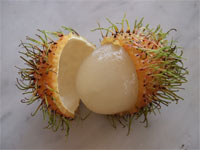 A Southeast Asian originating in Malaysia, it resembles a small hairy red ball and seems to have come right out of an animation of Miyazaki's imagination. The name rambutan comes from the Malay word "rambut" which means hair, as such the fruit is known as the hairy fruit. This adorable fruit is bright red and features many hairy hooks all over its exterior. The interior of this fruit is a translucent milky flesh which covers a brown seed in the center. The flesh of the rambutan is chewy and juicy and is tangy, sweet, and fragrant. In Southeast Asia, the rambutan fruit is typically sold in a bunch, during its fruiting season, roadside stalls are vibrant with red of the rambutans and families can be seen carrying bunches of this fruit home. A Southeast Asian originating in Malaysia, it resembles a small hairy red ball and seems to have come right out of an animation of Miyazaki's imagination. The name rambutan comes from the Malay word "rambut" which means hair, as such the fruit is known as the hairy fruit. This adorable fruit is bright red and features many hairy hooks all over its exterior. The interior of this fruit is a translucent milky flesh which covers a brown seed in the center. The flesh of the rambutan is chewy and juicy and is tangy, sweet, and fragrant. In Southeast Asia, the rambutan fruit is typically sold in a bunch, during its fruiting season, roadside stalls are vibrant with red of the rambutans and families can be seen carrying bunches of this fruit home.
Jackfruit
From afar, the jackfruit's exterior can easily mistaken the durian with its greenish longish shape and its hard shell-like exterior, but closer inspection the jackfruit actually looks quite different from the durian. For one, it does not have the sharp spikes of the durian. Native to Malaysia and much of Southeast Asia, the jackfruit also grows in Brazil and Jamaica where the climate supports its flourish.
The name jackfruit came from the Portuguese name for this fruit "jaca" which, in turn was derived from its Malay name "chakka".
The flesh of the jackfruit once you get past its shell is a unique thick and chewy, and has been described as starchy and fibrous. Its flesh is also in an interesting shade of vibrant orange. It has a unique strong taste that is at once sweet and distinctive.
Starfruit
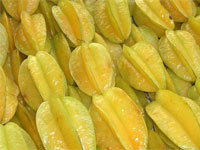 Also known as Carambola, the starfruit is native to the Phillipines and Indonesia. It given its name beacause when cut cross-section, the cut slices resemble little stars. Starfruits feature five ridges and are light green and feature a waxy exterior. Its flesh is translucent and light yellow in color. Also known as Carambola, the starfruit is native to the Phillipines and Indonesia. It given its name beacause when cut cross-section, the cut slices resemble little stars. Starfruits feature five ridges and are light green and feature a waxy exterior. Its flesh is translucent and light yellow in color.
The entire starfruit is edible including the skin. The texture of starfruits is crunchy, firm and juicy. Starfruits are cooling and qunching and hence is extremely popular in Southeast Asia and across Asia, especially during the hot summer months.
Milder Options
Not all Asian fruits are flamboyant in appearance and highly flavorful, there are also subtler Asian fruits that are just as popular and well loved.
Lychee
The favorite fruit of the famous Concubine Yang of the Tang dynasty Emperor, lychee is a highly popular fruit all across Asia. Fruit of a sub-tropical tree, the lychee is native to China, Taiwan, Bangladesh and Southeast Asia. Featuring a red crispy shell, the interior of the lychee is delicate and wispy in texture with translucent milky flesh that is at once sweet and juicy wrapped around a single brown seed.
Longan
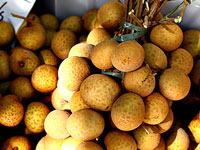 Belonging to the same family as the lychee, the longan is a cousin to the lychee fruit. Just like the lychee, the longan also features a crunchy shell that is brown in color and which is peeled before enjoying the juicy and sweet flesh of the fruit, which like the lychee has a single seed in the center. Belonging to the same family as the lychee, the longan is a cousin to the lychee fruit. Just like the lychee, the longan also features a crunchy shell that is brown in color and which is peeled before enjoying the juicy and sweet flesh of the fruit, which like the lychee has a single seed in the center.
When enjoying the longan fruit, the translucent juicy flesh is eaten and the seed is discarded. Longan flesh is typically more chewy than the lychee flesh, and is less sweet, but more quenching and subtler.
Yuzu
A highly popular fruit in Japan, the yuzu originates in East Asia. A citrus fruit, the yuzu resembles many other citrus fruits in that it has a thick dimpled skin that protects the fruit's flesh. Yuzu resembles a grapefruit in appearance and is typically yellow or green depending on the ripeness. Yuzu has a tart flavor with hints of citrusy fragrance, and its fresh zesty flavor is highly popular in Japanese cuisine. Yuzu juice is also use for seasoning in both Japanese and Korean cooking. In Korea, yuzu is also used to create a thick marmalade like syrup that is used to create "yujacha" which literally translates to yuzu tea.
The Rich and Varied World of Asian Fruits
The world of Asian fruits is a rich chapter that our monthly newsletter can only serve as a small opening for. We hope that through this month's newsletter you get a glimpse of some exotic, strange, tasty and interesting Asian fruits, and that the next time you visit an Asian supermarket to be sure to keep an eye out for a new type of Asian fruit that you may not have tried before. Get beyond its strange exterior, and get a taste of what Asian fruits can truly offer!
|
|
 |
OUR 2013 NEWSLETTERS
Exotic Fruit Kingdom- Journey into the World of Asian Fruits
Light Asian Snacks
Way of the Gods: Shintoism in Japan
The Chinese concept of Yin and Yang
Onsen: Japanese Hot springs—Enjoyment and Etiquette
Lunar New Year 2013: The Year of the Snake
Nabemono - Japanese Hot Pots
NEWSLETTER ARCHIVES
2013
2012
2011
2010
2009
2008
2007
2006
2005
2004
2003
2002
2001
|


 In Asia, the title of the "King of Fruits" goes to a unique fruit that at first sight and smell may be a put-off to many. A large fruit with a greenish brown hard spiky shell that has been described by many foreigners to smell like "gas leakage" or "dog droppings"-the durian is the undisputable King of fruits with its impressive appearance, and its unmistakable smell. But once you get past its hard spiky exterior, its insides are a rich silky golden yellow. What many has termed as a distasteful smell of the fruit, for the lovers of this fruit is one of its distinctive mark of the full rich experience that durians offer.
In Asia, the title of the "King of Fruits" goes to a unique fruit that at first sight and smell may be a put-off to many. A large fruit with a greenish brown hard spiky shell that has been described by many foreigners to smell like "gas leakage" or "dog droppings"-the durian is the undisputable King of fruits with its impressive appearance, and its unmistakable smell. But once you get past its hard spiky exterior, its insides are a rich silky golden yellow. What many has termed as a distasteful smell of the fruit, for the lovers of this fruit is one of its distinctive mark of the full rich experience that durians offer.  A Southeast Asian originating in Malaysia, it resembles a small hairy red ball and seems to have come right out of an animation of Miyazaki's imagination. The name rambutan comes from the Malay word "rambut" which means hair, as such the fruit is known as the hairy fruit. This adorable fruit is bright red and features many hairy hooks all over its exterior. The interior of this fruit is a translucent milky flesh which covers a brown seed in the center. The flesh of the rambutan is chewy and juicy and is tangy, sweet, and fragrant. In Southeast Asia, the rambutan fruit is typically sold in a bunch, during its fruiting season, roadside stalls are vibrant with red of the rambutans and families can be seen carrying bunches of this fruit home.
A Southeast Asian originating in Malaysia, it resembles a small hairy red ball and seems to have come right out of an animation of Miyazaki's imagination. The name rambutan comes from the Malay word "rambut" which means hair, as such the fruit is known as the hairy fruit. This adorable fruit is bright red and features many hairy hooks all over its exterior. The interior of this fruit is a translucent milky flesh which covers a brown seed in the center. The flesh of the rambutan is chewy and juicy and is tangy, sweet, and fragrant. In Southeast Asia, the rambutan fruit is typically sold in a bunch, during its fruiting season, roadside stalls are vibrant with red of the rambutans and families can be seen carrying bunches of this fruit home. Also known as Carambola, the starfruit is native to the Phillipines and Indonesia. It given its name beacause when cut cross-section, the cut slices resemble little stars. Starfruits feature five ridges and are light green and feature a waxy exterior. Its flesh is translucent and light yellow in color.
Also known as Carambola, the starfruit is native to the Phillipines and Indonesia. It given its name beacause when cut cross-section, the cut slices resemble little stars. Starfruits feature five ridges and are light green and feature a waxy exterior. Its flesh is translucent and light yellow in color.  Belonging to the same family as the lychee, the longan is a cousin to the lychee fruit. Just like the lychee, the longan also features a crunchy shell that is brown in color and which is peeled before enjoying the juicy and sweet flesh of the fruit, which like the lychee has a single seed in the center.
Belonging to the same family as the lychee, the longan is a cousin to the lychee fruit. Just like the lychee, the longan also features a crunchy shell that is brown in color and which is peeled before enjoying the juicy and sweet flesh of the fruit, which like the lychee has a single seed in the center.